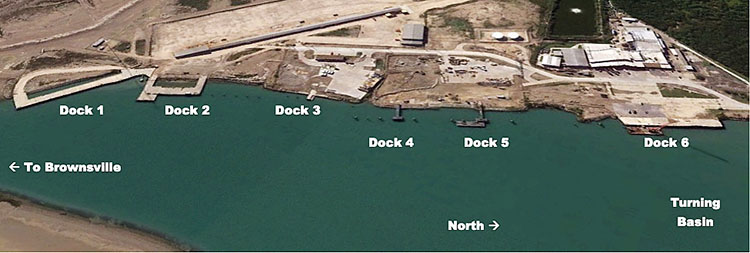By Scott Brown
CEO, Port Isabel
Economic growth and increased international trade are said to be growing U.S. port activity, but where in the heck is Port Isabel and how could it contribute?
Point Isabel, as it was originally named, was a major port and military base in the late 1800s—at the time of Texas’ birth and recurring battles and border skirmishes with Mexico and Spain. Now, Port Isabel is once again a hub of growing cross-border activity, as the U.S. re-enters Mexico’s oil and gas and products industry in a big way with the end of the PEMEX monopoly in Mexico.
After 10 years of slow, steady growth, PILOT Terminal in Port Isabel completed construction of new docks and pilings in late 2017, just in time for a 2018 explosion of activity. PILOT’s facility is jokingly referred to as ICWW MM 666, and encompasses docks 1 through 6, or all of the improved 40-foot-draft area along the west bank of the Port Isabel channel between the swing bridge and the Brownsville Channel “Y.”
Fleeting activity in the area has grown dramatically in 2018, with boats waiting on congested offloading schedules heading southwest into the Port of Brownsville or waiting on weather before passing through the swing-bridge and heading northeast up the Lower Laguna Madre toward the Land Cut. With more than 3,000 linear feet of waterfront encompassing the Port Isabel Turning Basin and broadening portion of the channel, Port Isabel has room for more than 10 tug and barge units at docks 1-6, and has hosted as many as 14 offshore and inland vessels at one time.
Inland companies like Kirby, Savage, Canal, E-Squared and others are growing activity in the area, and Port Isabel’s service offering has grown to meet their needs. Cranes and telehandlers support repair work on boats and barges, on top of basic fuel, water, lube, crew change and waste services. Kirby Corporation Barge Planner Ozzie Fuller has found the port’s location at the far southwestern end of the Gulf Intracoastal Waterway to be critical to his operations, saying “PILOT has helped me out of the frying pan more than a few times … and made sure we are able to keep our customers happy.”
Customer boats end up needing all kinds of parts, supplies, materials and technicians, ranging from HVAC to paint, flares and other needs. PILOT Operations Manager Sherri Brown says her team “can get just about anything done, like delivering a new washing machine in less than 30 minutes after receiving a boat’s request,” and highlights that “boats come to Port Isabel looking for solutions.”
Piped fuel service is among the safest and most efficient on the Gulf Coast, including 24-hour service with advance notice. Boats receive common carrier packages and hot shot deliveries, plus even use the port’s shuttle/trailer service to/from the HEB and Walmart located just one mile from the docks.
Besides the pickup in inland activity from growing U.S.-Mexico activity, 2018 saw Port Isabel as the bustling shore-base for construction of the first offshore pipeline connecting the U.S. to Mexico. Enbridge’s 42-inch natural gas pipeline will export Eagle Ford shale natural gas to Mexico’s electric utility infrastructure. PILOT Terminal is only four miles from the Gulf and has provided dock space and extensive services for more than 15 vessels involved in construction and surveying on both sides of the border. This project, with Allseas, Oceaneering and others as contractors, was Tidewater Capt. Billy Harris’ first visit back to Port Isabel since his inland work decades ago. He was “impressed by Port Isabel’s world-class people, facilities and offshore logistics services, right up there with what you would expect at the very top Gulf Coast shore-bases and logistics ports.”
The bottom line: PILOT’s mission in Port Isabel is to help increase the Gulf Coast’s contribution to U.S. economic growth, efficiency and energy independence, and team members who grew up on the Gulf Coast are proud to help put Port Isabel back on the map as U.S. oil and gas activity grows in Mexico.




